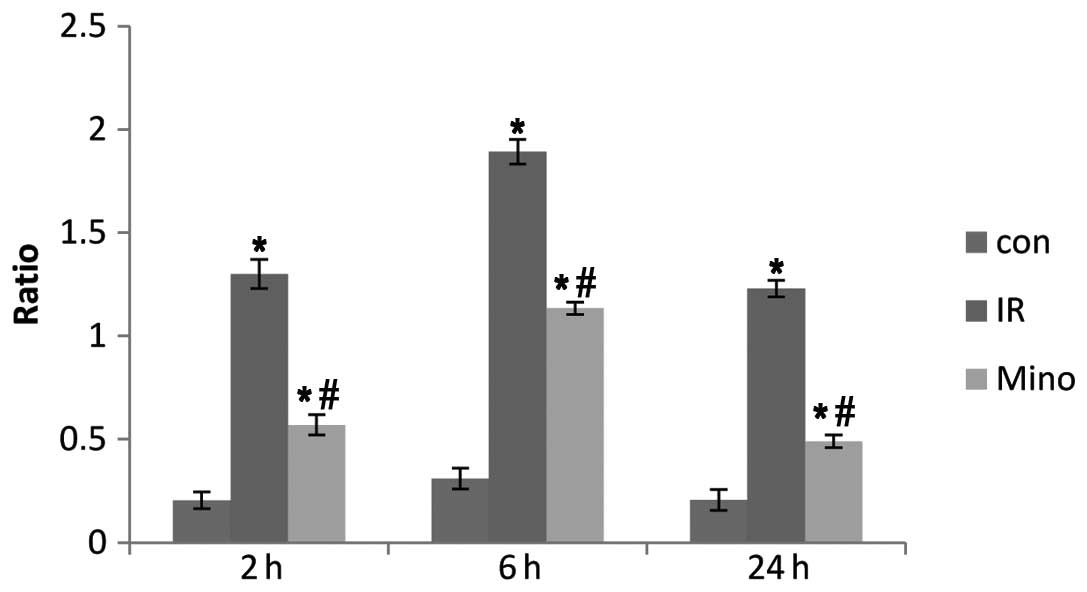|
1
|
Subhas G, Gupta A, Bakston D, et al:
Protective effect of methylprednisolone on warm
ischemia-reperfusion injury in a cholestatic rat liver. Am J Surg.
199:377–381. 2010. View Article : Google Scholar : PubMed/NCBI
|
|
2
|
Schauer RJ, Kalmuk S, Gerbes AL, et al:
Intravenous administration of glutathione protects parenchymal and
non-parenchymal liver cells against reperfusion injury following
rat liver transplantation. World J Gastroenterol. 10:864–870.
2004.
|
|
3
|
Su JF, Guo CJ, Wei JY, et al: Protection
against hepatic ischemia-reperfusion injury in rats by oral
pretreatment with quercetin. Biomed Environ Sci. 16:1–8.
2003.PubMed/NCBI
|
|
4
|
Que X, Debonera F, Xie J, et al: Pattern
of ischemia reperfusion injury in a mouse orthotopic liver
transplant model. J Surg Res. 116:262–268. 2004. View Article : Google Scholar : PubMed/NCBI
|
|
5
|
Jaeschke H: Reperfusion injury after warm
ischemia or cold storage of the liver: role of apoptotic cell
death. Transplant Proc. 34:2656–2658. 2002. View Article : Google Scholar : PubMed/NCBI
|
|
6
|
Jaeschke H: Molecular mechanisms of the
hepatic ischemia-reperfusion injury and preconditioning. Am J
Physiol Gastrointest Liver Physiol. 284:G15–G26. 2003.PubMed/NCBI
|
|
7
|
Griffin MO, Ceballos G and Villarreal FJ:
Tetracycline compounds with non-antimicrobial organ protective
properties: possible mechanisms of action. Pharmacol Res.
63:102–107. 2011. View Article : Google Scholar : PubMed/NCBI
|
|
8
|
Yu XD, Wu XH, Du XW, et al: Protective
effects of minocycline on renal ischemia-reperfusion injury in
rats. J Chongqing Med Univ. 32:1172–1174. 2007.
|
|
9
|
Plane JM, Shen Y, Pleasure DE, et al:
Prospects for minocycline neuroprotection. Arch Neurol.
67:1442–1448. 2010. View Article : Google Scholar : PubMed/NCBI
|
|
10
|
Abcouwer SF, Lin CM, Shanmugam S, et al:
Minocycline prevents retinal inflammation and vascular permeability
following ischemia-reperfusion injury. J Neuroinflammation.
10:1492013. View Article : Google Scholar : PubMed/NCBI
|
|
11
|
Zhai Y, Shen XD, O'Connell R, et al:
Cutting Edge: TLR4 activation mediates liver ischemia/reperfusion
inflammatory response via IFN regulatory factor 3-dependent
MyD88-independent pathway. J Immunol. 173:7115–7119. 2004.
View Article : Google Scholar : PubMed/NCBI
|
|
12
|
Xing HC, Li LJ, Xu KJ, et al: Intestinal
microflora in rats with ischemia/reperfusion liver injury. J
Zhejiang Univ Sci B. 6:14–21. 2005. View Article : Google Scholar
|
|
13
|
Zhou JX, Ye QF, Ming YZ, et al: Effects of
PNS on expression of nuclear factor-κB and ICAM-1 in rat liver
graft after ischemia reperfusion. Chin J Mod Med. 15:1330–1332.
2005.
|
|
14
|
Fondevila C, Busuttil RW and
Kupiec-Weglinski JW: Hepatic ischemia/reperfusion injury - a fresh
look. Exp Mol Pathol. 74:86–93. 2003. View Article : Google Scholar
|
|
15
|
Thobe BM, Frink M, Hildebrand F, et al:
The role of MAPK in Kupffer cell toll-like receptor (TLR) 2-,
TLR4-, and TLR9-mediated signaling following trauma-hemorrhage. J
Cell Physiol. 210:667–675. 2007. View Article : Google Scholar : PubMed/NCBI
|
|
16
|
Tsung A, Hoffman RA, Izuishi K, et al:
Hepatic ischemia/reperfusion injury involves functional TLR4
signaling in nonparenchymal cells. J Immunol. 175:7661–7668. 2005.
View Article : Google Scholar
|
|
17
|
Kolb M, Margetts PJ, Anthony DC, et al:
Transient expression of IL-1beta induces acute lung injury and
chronic repair leading to pulmonary fibrosis. J Clin Invest.
107:1529–1536. 2001. View
Article : Google Scholar : PubMed/NCBI
|
|
18
|
Griffin MO, Fricovsky E, Ceballos G, et
al: Tetracyclines: a pleitropic family of compounds with promising
therapeutic properties. Review of the literature. Am J Physiol Cell
Physiol. 299:C539–C548. 2010. View Article : Google Scholar : PubMed/NCBI
|
|
19
|
Fausto N, Campbell JS and Riehle KJ: Liver
regeneration. Hepatology. 43 (2 Suppl 1):S45–S53. 2006. View Article : Google Scholar
|
|
20
|
Kwon C, Arnold J, Hsiao EC, et al:
Canonical Wnt signaling is a positive regulator of mammalian
cardiac progenitors. Proc Natl Acad Sci USA. 104:10894–10899. 2007.
View Article : Google Scholar : PubMed/NCBI
|
|
21
|
Masckauchan TN, Shawber CJ, Funahashi Y,
et al: Wnt/beta-catenin signaling induces proliferation, survival
and interleukin-8 in human endothelial cells. Angiogenesis.
8:43–51. 2005. View Article : Google Scholar
|
|
22
|
Behari J, Yeh TH, Krauland L, et al:
Liver-specific beta-catenin knockout mice exhibit defective bile
acid and cholesterol homeostasis and increased susceptibility to
diet-induced steatohepatitis. Am J Pathol. 176:744–753. 2010.
View Article : Google Scholar
|
|
23
|
Kuncewitch M, Yang WL, Molmenti E, et al:
Wnt agonist attenuates liver injury and improves survival after
hepatic ischemia/reperfusion. Shock. 39:3–10. 2013. View Article : Google Scholar : PubMed/NCBI
|
|
24
|
Funato Y, Michiue T, Asashima M, et al:
The thioredoxin-related redox-regulating protein nucleoredoxin
inhibits Wnt-beta-catenin signaling through dishevelled. Nat Cell
Biol. 8:501–508. 2006. View
Article : Google Scholar : PubMed/NCBI
|
|
25
|
Essers MA, de Vries-Smits LM, Barker N, et
al: Functional interaction between beta-catenin and FOXO in
oxidative stress signaling. Science. 308:1181–1184. 2005.
View Article : Google Scholar
|
|
26
|
Goode HF, Webster NR, Howdle PD, et al:
Reperfusion injury, antioxidants and hemodynamics during orthotopic
liver transplantation. Hepatology. 19:354–360. 1994. View Article : Google Scholar : PubMed/NCBI
|














